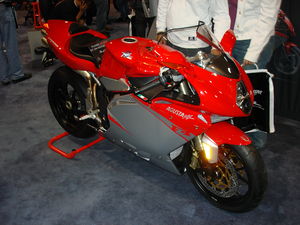MV Agusta F4 series
 |
|
| Manufacturer | MV Agusta |
|---|---|
| Parent company | Cagiva |
| Production | since 2006 |
| Class | Sport bike |
| Engine | 998 cc (60.9 cu in) liquid cooled inline four cylinder, 4 stroke, dohc, 16 radial valves, capacity cc (60.8 in³), max. |
| Bore / stroke | 76.0 mm × 55.0 mm (2.99 in × 2.17 in) |
| Compression ratio | 13:1 |
| Transmission | Multi-disc wet clutch, 6 speed cassette gearbox, chain drive |
| Frame type | TIG welded 25CrMo4-steel tubular trellis |
| Suspension | front: carbon-nitride coated 50 mm upside down fork, 129 mm (5.07 in) wheel travel, rear: single sided swingarm, single shock absorber, 120 mm (4.72 in) wheel travel |
| Brakes | front: double floating disc with 320 mm (12.6 in) diameter and radial-type monobloc calipers with 4 pistons, rear: single disc with 210 mm (8.27 in) diameter and a brake caliper with 4 pistons |
| Related | MV Agusta Brutale |
The MV Agusta F4 was the motorcycle that launched the resurrection of MV Agusta in 1998. The F4 was created by motorcycle designer Massimo Tamburini at CRC (Cagiva Research Center), following his work on the Ducati 916. The F4 has a four pipe undertail exhaust, single-sided swingarm, large front forks (49 or 50 mm diameter) and traditional MV Agusta red and silver livery. The F4 is also one of the few production superbikes to have a hemispherical chamber 4 valves per cylinder engine.
The F4 engine is a liquid cooled inline four cylinder four-stroke with two overhead camshafts (DOHC), 16 radial valves, electronic multipoint injection, induction discharge electronic ignition, with engine displacements of 749.5 cc (45.74 cu in), 998 cc (60.9 cu in), and 1,078 cc (65.8 cu in). The engine was derived from the 1990–1992 Ferrari Formula One engine. Early in the design process Ferrari engineers assisted in the development of the engine. MV (Cagiva at the time) quickly deviated from the Ferrari design, but they kept one important feature, the radial valves. The F4 engine is unique in the sense that it is the only radial valved motorcycle engine currently in production.
The F4 Tamburini, F4 Veltro, and F4 CC models are equipped with variable length intake ducts known as the "TSS" system. The "TSS" system is designed to increase torque in the low to midrange, while still allowing for max. horsepower at the top of the rev range (usually two mutually exclusive properties of an engine). The "TSS" system has two positions, it is not able to vary the height of the intake ducts continuously. "TSS" is able to lower peak torque from the 10000 rpm to 9000 rpm while maintaining maximum power. This system debuted on the F4 Tamburini and was lauded by independent motorcycling publications such as Australian Motorcycle News.
The first F4 model released to the public was the F4 750 Serie Oro on May 1999. Only 300 examples were produced. Many parts such as the swingarm, frame side plates and wheels were made from magnesium. These magnesium parts were anodized gold for consistency with the name 'Oro' (Italian for gold). All painted parts, such as fairings, seat cover, front mud guard and even the fuel tank and air box are made of carbon. It's only by using these materials that the weight could be kept under 400 lb which is only beaten by the F4 Veltro. The specially for MV Agusta developed Showa fork has fast detach axle clamps. The six piston (front) and 4 piston (rear) brake calipers are made by Nissin.
...
Wikipedia
